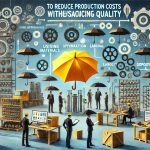As global environmental concerns continue to grow, businesses in all industries, including umbrella manufacturing, are under increasing pressure to adopt sustainable practices. The production of umbrellas, while a relatively simple process, involves various components, from the canopy material to the frame and handle, each of which presents an opportunity for a more eco-friendly approach. Manufacturers today are not only focused on reducing costs and increasing efficiency but also on ensuring that their production methods are environmentally responsible.
Incorporating sustainability into umbrella production can be a challenge, given the variety of materials involved, the need for durable products, and the long supply chains typical of the umbrella industry. However, the benefits of sustainable practices—both for the planet and the brand—are significant. Sustainable production methods can reduce waste, conserve resources, and attract environmentally conscious consumers, helping brands stay competitive in an increasingly eco-aware market.
Sustainable Sourcing of Raw Materials
The foundation of any sustainable product is the responsible sourcing of materials. In the case of umbrellas, this includes the fabric, frame, handle, and other components like tips and rivets. Manufacturers must consider the environmental impact of each material and look for alternative options that minimize harm to the planet.
Choosing Eco-Friendly Fabrics
The fabric used for umbrella canopies is a key component in the product’s environmental footprint. Traditionally, umbrella fabrics are made from synthetic materials like polyester or nylon, which are derived from petroleum-based resources and can take hundreds of years to decompose in landfills. However, there are now a variety of sustainable fabric options available to replace conventional materials.
Organic Cotton and Hemp
Organic cotton is grown without the use of harmful pesticides or synthetic fertilizers, making it a more environmentally friendly choice than conventional cotton. Additionally, hemp fabric is another eco-friendly option, as hemp requires less water and fewer pesticides to grow compared to cotton.
- Benefits: Both organic cotton and hemp fabrics are biodegradable, unlike synthetic materials, which contribute to plastic waste. These fabrics are also more breathable and can offer natural UV protection, making them ideal for outdoor use.
- Challenges: One of the challenges of using these materials is that they may not be as durable or water-resistant as synthetic alternatives. To overcome this, manufacturers can look for advanced treatments or coatings that maintain the eco-friendly qualities while improving performance.
Recycled Fabrics
Another popular option in sustainable umbrella production is the use of recycled materials, such as recycled polyester (rPET). This material is made from post-consumer plastic bottles and other plastic waste, reducing the need for virgin resources.
- Benefits: Recycled fabrics help divert waste from landfills and reduce the environmental impact associated with the production of new polyester. Recycled fabrics are also available in a range of textures and finishes that can mimic the performance characteristics of traditional fabrics.
- Challenges: While recycled polyester can be a more sustainable option, it still comes with some environmental impact, particularly in terms of energy consumption during processing. However, advancements in recycling technologies are helping to make this process more efficient and eco-friendly.
Sustainable Materials for Frames and Handles
The frame and handle of an umbrella are typically made from materials such as steel, aluminum, and plastic, each with varying levels of environmental impact. To ensure sustainability, manufacturers need to choose materials that are both durable and recyclable.
Bamboo
Bamboo is a fast-growing, renewable resource that has gained popularity as an eco-friendly alternative to traditional umbrella frame materials. Bamboo is lightweight, strong, and biodegradable, making it a viable option for sustainable umbrella production.
- Benefits: Bamboo is a highly renewable resource that grows without the need for chemical fertilizers or pesticides. It is also biodegradable, so it won’t contribute to landfill waste at the end of its life cycle.
- Challenges: The primary challenge with bamboo is ensuring its durability and strength to withstand wind and rain. Some manufacturers may need to combine bamboo with other materials or coatings to enhance its structural integrity and water resistance.
Recycled Metals
Instead of using new metal alloys, manufacturers can opt for recycled metals like aluminum or steel. These metals are 100% recyclable and require significantly less energy to process compared to virgin metals, reducing their carbon footprint.
- Benefits: Recycled metals are durable, lightweight, and can be reused multiple times, making them an excellent choice for umbrella frames. Using recycled materials reduces the need for mining and refining raw materials, which is an energy-intensive process.
- Challenges: The cost of processing recycled metals can be slightly higher compared to using virgin materials. However, the long-term environmental benefits and potential savings in raw material costs can offset this investment.
Biodegradable Plastics
Plastic is commonly used in umbrella handles, tips, and other small parts. While plastic is durable, it poses a significant environmental challenge when discarded. Biodegradable plastics, which break down more easily in the environment, offer a more sustainable alternative.
- Benefits: Biodegradable plastics help reduce long-term waste in landfills and oceans, making them a better alternative to traditional plastic components. They are also often made from renewable resources such as cornstarch or sugarcane.
- Challenges: Biodegradable plastics often require specific conditions to break down, and they may not always perform as well as conventional plastics in terms of durability and strength. Manufacturers need to carefully evaluate their use in umbrella components.
Sustainable Manufacturing Processes
Once raw materials have been sourced, the next step in ensuring sustainability is to adopt eco-friendly manufacturing processes. This can include reducing energy consumption, minimizing waste, and implementing efficient production techniques that reduce the overall environmental impact.
Reducing Energy Consumption
Energy consumption is one of the largest contributors to the carbon footprint of manufacturing processes. By adopting energy-efficient machinery and practices, umbrella manufacturers can significantly reduce their environmental impact.
Renewable Energy
Manufacturers can shift to renewable energy sources such as solar, wind, or hydroelectric power to reduce their reliance on fossil fuels. Some umbrella manufacturers are already making the switch to green energy, either by installing on-site solar panels or purchasing green energy from their utility providers.
- Benefits: Transitioning to renewable energy reduces greenhouse gas emissions and reliance on non-renewable resources, helping manufacturers achieve their sustainability goals. It also lowers the long-term cost of energy by taking advantage of more stable and sustainable energy sources.
- Challenges: The initial investment in renewable energy infrastructure can be expensive, and the availability of renewable energy may vary depending on the region. However, incentives and tax breaks are often available to offset these costs.
Energy-Efficient Equipment
Investing in energy-efficient equipment is another way to reduce energy consumption in umbrella production. Machines that are optimized for energy use consume less power, making the production process more sustainable.
- Benefits: Energy-efficient equipment reduces electricity bills, decreases carbon emissions, and helps manufacturers comply with environmental regulations. Over time, the savings in energy costs can offset the initial investment in upgraded machinery.
- Challenges: The upfront cost of purchasing energy-efficient equipment can be high, but the long-term operational savings and environmental benefits make it a worthwhile investment.
Waste Reduction and Recycling
Waste management is another critical component of sustainable manufacturing. Reducing waste through lean production methods, recycling scrap materials, and reusing production by-products can help minimize the environmental impact of the umbrella manufacturing process.
Lean Manufacturing
Lean manufacturing focuses on minimizing waste in all stages of production. By eliminating unnecessary steps, optimizing workflows, and improving material usage, manufacturers can significantly reduce the amount of waste generated during production.
- Benefits: Lean manufacturing not only reduces environmental waste but also improves efficiency, reduces production costs, and boosts profitability. By cutting down on overproduction and minimizing defects, manufacturers can also improve product quality.
- Challenges: Implementing lean manufacturing practices requires a cultural shift within the organization, as well as investment in training and process optimization. However, the long-term benefits in terms of waste reduction and cost savings are substantial.
Recycling Production Materials
Many umbrella manufacturers use large quantities of fabric and metal, which can produce significant amounts of scrap material. Recycling these materials rather than sending them to landfills can help reduce waste and lower production costs.
- Benefits: Recycling production materials, such as fabric scraps or metal offcuts, prevents valuable resources from going to waste. Recycled materials can be repurposed for other products, reducing the need for new raw materials and lowering production costs.
- Challenges: Efficient recycling systems require investment in equipment and infrastructure, and not all materials can be easily recycled. However, with careful planning, manufacturers can set up effective recycling programs to maximize material reuse.
Sustainable Packaging Solutions
Packaging is often one of the most visible elements of a product’s sustainability credentials. For umbrellas, the packaging serves not only to protect the product during transit but also as a key marketing tool. As consumers increasingly demand eco-friendly packaging, manufacturers can adopt sustainable packaging solutions to reduce their environmental footprint.
Eco-Friendly Packaging Materials
Traditional packaging materials, such as plastic wraps and Styrofoam, contribute significantly to waste. Switching to biodegradable, recyclable, or reusable packaging materials can help reduce the environmental impact of umbrella packaging.
Recycled Paper and Cardboard
Using recycled paper and cardboard for umbrella packaging is a simple but effective way to reduce waste. These materials are widely recyclable and often come from post-consumer or post-industrial waste, making them a more sustainable option compared to virgin paper products.
- Benefits: Recycled paper and cardboard reduce the need for new wood pulp, helping to conserve forests and reduce the carbon footprint associated with paper production. Additionally, they are often lighter than other packaging materials, which can reduce shipping costs.
- Challenges: Recycled paper and cardboard may not always be as strong or durable as virgin materials, requiring careful design to ensure the protection of the product during shipping.
Biodegradable Plastics
For some components, biodegradable plastics made from natural materials such as cornstarch or plant-based resins can be used as an alternative to traditional plastic packaging.
- Benefits: Biodegradable plastics break down more easily in the environment, reducing plastic waste in landfills. They are also often made from renewable resources, helping to reduce the reliance on petroleum-based plastics.
- Challenges: While biodegradable plastics have significant environmental benefits, they may not always perform as well as traditional plastics in terms of durability and water resistance.
Reducing Packaging Waste
Another key strategy for sustainable packaging is reducing the overall amount of packaging used. By designing packaging that is minimal yet effective, manufacturers can reduce waste and improve overall sustainability.
Streamlined Packaging Design
By adopting a minimalist packaging design, manufacturers can reduce the use of unnecessary materials such as excess filler, padding, or multiple layers of packaging. This approach reduces both material waste and transportation costs, as smaller packages are more efficient to ship.
- Benefits: Streamlined packaging reduces the environmental impact of production and shipping, as less material is used and fewer resources are required for transportation.
- Challenges: Manufacturers must strike a balance between reducing packaging waste and ensuring that the product is adequately protected during shipping.
Conclusion
Ensuring sustainability in umbrella production is an ongoing process that involves a holistic approach across various stages of manufacturing. By sourcing eco-friendly materials, adopting energy-efficient processes, minimizing waste, and utilizing sustainable packaging solutions, manufacturers can significantly reduce their environmental impact. While challenges remain, the benefits of sustainable production—both environmentally and economically—are clear. As consumer demand for sustainable products grows, the umbrella industry must continue to innovate and adapt to meet these expectations, ensuring a greener future for both the planet and the business.







